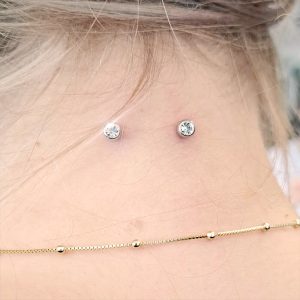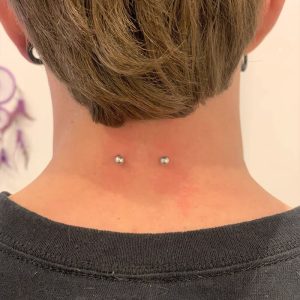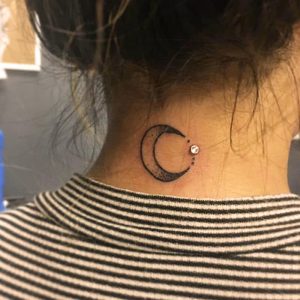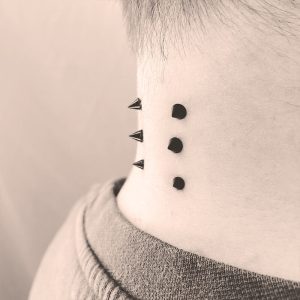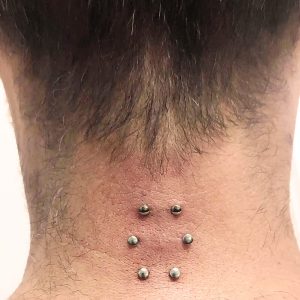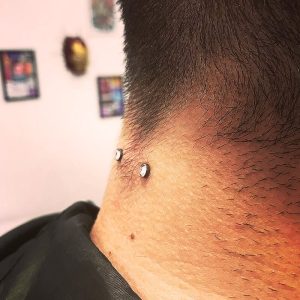Craving a unique yet discreet piercing? Discover the hidden gem of nape piercings – intimate, stylish, and perfect for those who cherish their secrets. This one-of-a-kind piercing, located at the back of the neck, is perfect for body art enthusiasts who want to stand out without having too many visible piercings. With its limited visibility, you get to decide who sees it, making it a truly intimate and personal experience.
Ready to embrace this cool, lesser-known piercing? Dive into the world of nape piercings and make a statement that’s uniquely you.
Key Points
- Nape piercing is located at the back of the neck, making it less visible to others.
- Nape piercing is a type of surface piercing that involves two entry points connected by a single piece of jewelry.
- The cost of a nape piercing ranges from $30 to $60, and the healing time is generally 4 to 8 months.
- Nape piercing are considered moderately painful.
- Nape piercings come with certain risks such as infection, migration, and rejection, nerve damage, allergic reactions, and snagging and irritation.
What is a nape piercing?
A nape piercing is a type of surface piercing that is strategically placed on the back of the neck, specifically in the nape area. This unique body modification consists of two entry points—an entry and an exit hole—connected by a single piece of jewelry that sits beneath the skin’s surface. The jewelry used is usually a surface barbell, which is designed explicitly for surface piercings to minimize the risk of rejection and migration.
Nape piercings are sometimes referred to as “neck piercings,” but this term can be misleading, as there are various other piercing options for the neck area, such as dermal piercings or collarbone piercings. To ensure clear communication with your piercer, it is best to use the term “nape piercing” when discussing this specific type of neck piercing. Additionally, the placement of the nape piercing makes it an excellent choice for those who wish to experiment with body piercing without committing to more visible or easily noticeable modifications.
Voir cette publication sur Instagram
| Nape Piercing Type | Placement | Pricing | Pain Level | Healing Time |
|---|---|---|---|---|
| Horizontal Nape Piercing | Horizontally on the back of the neck | $30 – $60 | 7/10 | 4-8 months |
| Vertical Nape Piercing | Vertically on the back of the neck | $30 – $60 | 7/10 | 4-8 months |
Nape surface piercing vs nape dermal piercing
Nape surface piercing and nape dermal piercing are two different types of piercings that can be done on the nape or back of the neck. Here, we will discuss the differences between the two.
-
Nape surface piercing
A nape surface piercing is a type of surface piercing that involves two entry and exit points on the back of the neck. The piercer uses a hollow needle to create a channel under the skin, through which a surface barbell or flexible bar is inserted. The jewelry sits flush with the skin, and both ends of the bar are visible. Nape surface piercings are prone to migration and rejection due to the constant movement of the neck and the pressure exerted by clothing or hair.
-
Nape dermal piercing
A nape dermal piercing, also known as a microdermal or single-point piercing, involves only one entry point in the skin. In this type of piercing, a small dermal anchor is inserted beneath the skin, and a dermal top or decorative end is screwed into the anchor, sitting flush with the skin’s surface. Dermal piercings require a skilled piercer to perform, as they involve the use of a dermal punch or needle to create a small pocket in the skin for the anchor.
| Feature | Nape Surface Piercing | Nape Dermal Piercing |
|---|---|---|
| Technique | Two entry points
Channel under the skin |
One entry point
Anchor beneath skin |
| Jewelry | Surface barbell or flexible bar | Dermal anchor with decorative top |
| Visibility | Two visible ends | One visible end |
| Healing & Rejection | More prone due to neck movement | Less prone |
| Removal | Easier | May require professional removal |
| Aesthetic Appeal | More linear look | Singular point of adornment |
Nape Piercing Procedure
The nape piercing process begins with a consultation to determine jewelry placement. Barbell jewelry is typical for nape piercings, so consider the placement of both ends on your neck. While nape piercings may appear simple in design, they require a skilled and experienced piercer to perform the procedure correctly.
The piercer must accurately measure and mark the entry and exit points on the back of the neck, ensuring that the placement is suitable for the individual’s anatomy and the chosen jewelry. Once the markings are confirmed, the piercer will use a hollow needle to create the two holes and thread the jewelry under the skin, connecting the entry and exit points. The surface barbell’s ends should sit flush with the skin’s surface, ensuring a smooth and visually appealing result.
@louispiercer 🗡NAPE PIERCING🗡 #napepiercing #surfacepiercing #piercingvideo #piercingfreehand #piercing #piercer #pierced #piercings #piercingtutorial #piercersoftiktok ♬ Whoopty (Instrumental) – DJB
Do nape piercings hurt?
The pain level associated with nape piercings varies for each individual, as it depends on personal pain tolerance and the piercer’s technique. Generally, nape piercings are considered moderately painful compared to other types of piercings. On a scale of 1-10, the pain level for a nape piercing is around 7.
Compared to other neck or surface piercings, the nape piercing might be slightly more painful due to the location and the type of tissue involved. Surface piercings in areas with thinner skin or fewer nerve endings, such as earlobes or eyebrows, might be less painful than a nape piercing. However, everyone’s pain threshold is different, and what might be painful for one person could be tolerable for another.
How much does a nape piercing cost?
The cost of a nape piercing varies based on factors such as location, the skill and reputation of the piercer, and the type of jewelry chosen. Generally, you can expect to pay between $30 and $60 for a nape piercing, not including the cost of the jewelry. High-quality, hypoallergenic materials such as titanium or surgical steel are recommended to reduce the risk of infection and allergic reactions.
How long does it take for a nape piercing to heal?
The healing time for a nape piercing varies depending on several factors, including the individual’s immune system, the type of jewelry used, and how well the aftercare routine is followed. Generally, nape piercings take anywhere from 4 to 8 months to heal completely. In some cases, it may take even longer for the piercing to fully heal.
During the healing process, it’s essential to follow a proper aftercare routine, including regularly cleaning the piercing with a saline solution and avoiding touching or twisting the jewelry. Additionally, it’s crucial to avoid putting pressure on the piercing, such as by sleeping on the back of your neck or wearing tight clothing that may irritate the area. By adhering to the recommended aftercare practices and consulting with a professional piercer if any issues arise, you can help ensure a smooth and successful healing process for your nape piercing.
How to clean a nape piercing?
Properly cleaning a nape piercing is essential for promoting healthy healing and preventing infections. Here are some steps to follow when cleaning a nape piercing:
- Wash your hands thoroughly with soap and water to ensure they are clean before touching the piercing.
- Prepare a saline solution by dissolving 1/4 teaspoon of non-iodized sea salt in 8 ounces (240 ml) of warm distilled or bottled water.
- Soak a sterile cotton ball or swab in the saline solution and gently apply it to the piercing area, ensuring that the solution reaches both entry and exit points. You can also use a pre-made saline wound wash.
- Gently remove any crust or debris around the piercing with the cotton swab. Be careful not to press too hard or pull on the jewelry.
- After cleaning, pat the area dry with a clean, soft towel or tissue paper. Avoid using a towel that could leave lint or fibers on the piercing.
- Perform this cleaning routine twice daily until the piercing is fully healed, which usually takes 5-6 months.
Popular Jewelry for Nape Piercings
Nape piercings can be adorned with different types of jewelry, such as surface barbells, flexible bars, and curved barbells. The most common choice for nape piercings is a surface barbell, which features a straight or slightly curved bar with two removable ends that can be customized with various decorative elements. Surface barbells are specifically designed for surface piercings and sit flat against the skin, minimizing the risk of snagging or irritation.
Alternatively, flexible bars made from materials like PTFE or Bioplast can be used. These bars offer better adaptability to the natural movements of the neck, reducing pressure on the piercing and lowering the risk of rejection. Curved barbells may also be utilized in some cases, where the curvature of the neck and the piercing’s placement call for a more curved jewelry shape.
In addition to surface barbells, nape piercings can also be done using surface anchors or micro-dermals. Surface anchors are implanted under the skin, creating a single point of attachment rather than two separate holes. They offer more flexibility in terms of placement and can be arranged in various patterns, horizontally or vertically. While surface anchors may be less durable than surface barbells and more prone to falling out or being pulled out, they provide a unique aesthetic and versatile placement options.
Voir cette publication sur Instagram
What are the risks associated with nape piercings?
Nape piercings, like any other body piercing, come with certain risks. Some of the common risks associated with nape piercings include:
- Infection: Poor aftercare or touching the piercing with unclean hands can introduce bacteria and lead to an infection.
- Migration and rejection: The body may perceive the jewelry as a foreign object and try to push it out, causing the piercing to migrate or be completely rejected. This can result in scarring or an uneven appearance.
- Keloids or hypertrophic scarring: Some individuals are more prone to developing keloids or hypertrophic scars, which are raised scars that form around the piercing site.
- Nerve damage: Although rare, there’s a possibility of nerve damage if the needle accidentally hits a nerve during the piercing process.
- Allergic reactions: Some people may experience an allergic reaction to certain metals used in the jewelry, such as nickel.
- Snagging and irritation: Long hair or clothing can catch on the jewelry, causing discomfort or even tearing the piercing.
- Pressure sores: Constant pressure on the nape piercing (e.g., from sleeping on it) can cause pressure sores, prolonging the healing process and potentially leading to other complications.
How to Change or Remove Nape Piercing Jewelry?
Changing or removing nape piercing jewelry can be challenging due to its location on the back of your neck. Before attempting it, ensure your piercing is fully healed and clean your hands and the area around the piercing. Prepare the new jewelry by sterilizing it with a piercing-specific solution or rubbing alcohol. Depending on the jewelry type, either unscrew the ends of a surface bar or gently lift the top of a dermal anchor, then carefully remove the old jewelry and insert the new one. Secure the new jewelry in place and clean the area with a saline solution or piercing-specific cleanser. However, since nape piercings are difficult to access, it’s highly recommended to return to your piercer to ensure proper and safe jewelry change.
What are the other types of nape and neck piercing ?
There are various types of nape and neck piercings that individuals can choose from, depending on their personal style and preferences. Some common nape and neck piercings include:
- Horizontal Nape Piercing: A standard nape piercing is a horizontal surface piercing located on the back of the neck. The jewelry used is typically a surface bar or flexible barbell, with two visible balls or decorative ends on either side of the piercing.
- Vertical Nape Piercing: This piercing is similar to the traditional nape piercing but is oriented vertically rather than horizontally. It may involve a single vertical piercing or multiple piercings to create a pattern or design.
- Nape Microdermal Piercing: These piercings consist of single-point dermal anchors inserted under the skin on the back of the neck. They can be placed in various patterns, either symmetrically or asymmetrically, and can feature different types of jewelry ends for a unique look.
- Collarbone Piercing: Also known as clavicle piercings, these surface piercings are placed horizontally above the collarbone on either side of the neck. They are typically performed using surface bars, with two visible ends on each side of the piercing.
- Corset Nape Piercing: This style consists of multiple piercings that are arranged in two parallel rows along the nape, resembling the appearance of a corset. The piercings are typically connected using ribbons or chains, creating a stunning and intricate design.
- Neck Web Piercing: This is a less common type of neck piercing that targets the fold of skin between the clavicles, also known as the “neck web.” This piercing can be done using a curved barbell or a captive bead ring.
- Vampire Bites Piercing: Vampire bites are a set of two surface piercings or dermal piercings placed on either side of the neck, mimicking the appearance of a vampire’s bite. They can be done horizontally or vertically, depending on the individual’s preference.
It is important to note that not all neck and nape piercings are suitable for everyone, as factors such as anatomy, lifestyle, and personal preferences can impact the success and longevity of these piercings. Consulting with a professional and experienced piercer is essential to determine the best type of neck or nape piercing for your unique circumstances.
Voir cette publication sur Instagram
Nape piercing images gallery
Neck piercing requires a great deal of skill and knowledge to be performed safely and carries a number of risks. It is important to work with an experienced and reputable piercer who follows proper hygiene and safety protocols, and to be well prepared for the experience. With the proper precautions and care, nape piercing can be a safe and rewarding experience for those who choose to undergo it.
Frequently Asked Questions
Can I hide my nape piercing?
Nape piercings can be easily concealed with clothing, hair, or even a small bandage if necessary. This makes them an ideal choice for those who want a discreet body modification.
How long should I wait before changing the jewelry?
It’s best to wait until the piercing is fully healed before changing the jewelry, which can take between two and six months. Consult your piercer for personalized advice.
Can I sleep on my back with a nape piercing?
Sleeping on your back with a fresh nape piercing may cause discomfort or irritation. Try sleeping on your side or using a travel pillow to avoid putting pressure on the piercing.
Can I exercise with a nape piercing?
You can exercise with a nape piercing, but take precautions to avoid snagging, irritation, or excessive sweat around the piercing. Keep the area clean and dry after workouts.

